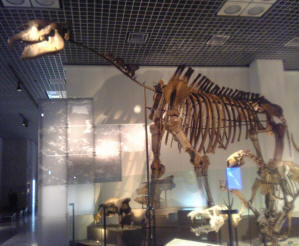Discovery
 The first Paraceratherium fossils were found in
1846 by a soldier named Vickary, however, not much else is known
about Vickary's experience.
The first Paraceratherium fossils were found in
1846 by a soldier named Vickary, however, not much else is known
about Vickary's experience.
Other research about the Paraceratherium begins with Henry Guy
Ellock Pilgrim. His greatest paleontological contribution came
from mapping and fossil collecting in the Siwalik Hills, which
is now Pakistan (Prothero, 2013). This is what lead him to the
first discovery of the Paraceratherium in 1907. Although, he
did not realize what he had found, he published papers about the
loose upper and lower teeth and the back of a jaw of the
Paraceratherium, which he originally named
Aceratherium
bugtiense in his Memoir of the Geological Survey of India,
1912 (Lewis, 1944).
After hearing about Dr. Guy Pilgrim’s discoveries in India,
Sir Clive Forster Cooper wanted to go see the sites in
Baluchistan and in 1911 he extracted a large bone bed of the
Aceratherium bugtinse. This
was the first collection of a large series of skulls and skeletons.
By the end of the year, Forster Cooper renamed it Paraceratherium.
One of the most famous expeditions involving the extraction of
Paraceratherium bones was in 1922. This was led by Roy Chapman
Andrews and included Walter Granger, Charles P. Berkey,
Frederick K. Morris and Henry Fairfield Osborn, named “the
biggest scientific expedition ever to leave the United States”
(Prothero, 2013).
During the third field season at Loh in Central Asia, 1925, the
group made their most incredible find as described by Andrews in
his writings:
“The credit for the most interesting discovery at Loh belongs to
one of our Chinese collectors, Liu Hsi-ku. His sharp eyes
caught the glint of a white bone in the red sediment of the
steep hillside. He dug a little and then reported to Granger
who completed the excavation. He was amazed to find the foot
and lower leg of the Baluchitherium standing up-right, as if
the animal had carelessly left it behind when he took another
stride”.
The other three leg bones were also collected at the same site,
all standing up-right. It was later determined that the
Paraceratherium was stuck in a bed of quicksand and was unable
to free itself and therefore, died there (Prothero, 2013).